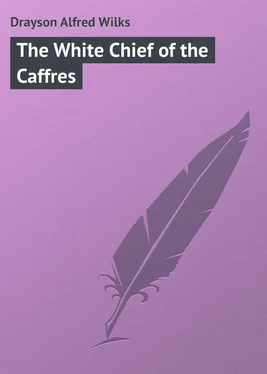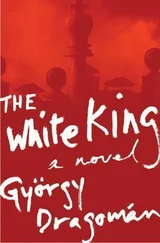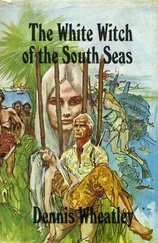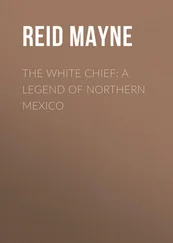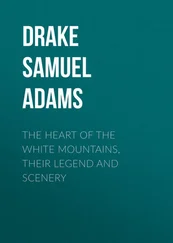Alfred Drayson - The White Chief of the Caffres
Здесь есть возможность читать онлайн «Alfred Drayson - The White Chief of the Caffres» — ознакомительный отрывок электронной книги совершенно бесплатно, а после прочтения отрывка купить полную версию. В некоторых случаях можно слушать аудио, скачать через торрент в формате fb2 и присутствует краткое содержание. Жанр: Прочие приключения, foreign_prose, на английском языке. Описание произведения, (предисловие) а так же отзывы посетителей доступны на портале библиотеки ЛибКат.
- Название:The White Chief of the Caffres
- Автор:
- Жанр:
- Год:неизвестен
- ISBN:нет данных
- Рейтинг книги:4 / 5. Голосов: 1
-
Избранное:Добавить в избранное
- Отзывы:
-
Ваша оценка:
- 80
- 1
- 2
- 3
- 4
- 5
The White Chief of the Caffres: краткое содержание, описание и аннотация
Предлагаем к чтению аннотацию, описание, краткое содержание или предисловие (зависит от того, что написал сам автор книги «The White Chief of the Caffres»). Если вы не нашли необходимую информацию о книге — напишите в комментариях, мы постараемся отыскать её.
The White Chief of the Caffres — читать онлайн ознакомительный отрывок
Ниже представлен текст книги, разбитый по страницам. Система сохранения места последней прочитанной страницы, позволяет с удобством читать онлайн бесплатно книгу «The White Chief of the Caffres», без необходимости каждый раз заново искать на чём Вы остановились. Поставьте закладку, и сможете в любой момент перейти на страницу, на которой закончили чтение.
Интервал:
Закладка:
I was so fully occupied with the work that was drawn out for me by the Caffres, that I had not thought with much anxiety about my late fellow-passengers. I wished, however, to see Constance, and now that I could speak a little in the Caffre language, I asked where she was, and when I could see her. My inquiry and wish seemed to puzzle Inyoni, who told me she was well, but that I must not see her yet, as the chief had so ordered it. So, during six months I never saw a white person, and by that time I was to all purposes a regular Caffre boy. I could speak the language well, I could click out the proper clicks at right words, could throw an assagy better than any Caffre boy of my size. I could run faster than other Caffre boys, though I could not keep it up so well, but for a quarter of a mile I was very fast. I knew nearly every cow’s name, and could whistle and drive a herd of cattle like a Caffre. The one thing from which I suffered was the tenderness of my feet. My boots had been worn out long since, and my feet, from having worn shoes all my life, were very tender; but each day they became harder, though I often had to stop and sit down when I had trodden on a sharp stone. My only suit of clothes was worn out, but I had made a set of what the Caffres considered clothes, but were merely strips of goat’s-skin about a foot long, fastened to a leather strap round my waist. This absence of dress I found caused me to be too hot in the warm weather and too cold in the early mornings and in the cold weather; but I hardened under the conditions, and soon did not mind it.
There was an amusement that I and my two companions carried on which I afterwards found very useful. This was to procure two or three straight canes about five feet long: one end of these we used to cover with clay, we then stood opposite each other, and danced and jumped about, and then suddenly threw these at, each other, using them like an assagy. At first the Caffres used to hit me at nearly every shot, and I never touched them; but after considerable practice I became as expert as they were, and could spring on one side so as just to avoid the blow, or throw myself down, or turn the spear aside with my shield, which was an oval-shaped piece of ox-hide. At about thirty paces from each other we could never hit one another, and then we closed in till one of us was hit. We used to keep a score on a stick of the number of hits against each of us, a notch in the stick being the mark. In after years, when it was a matter of life and death, the training and practice I had gained in my boyhood was of vital importance to me in avoiding an assagy, when one was thrown at me, and my dexterity in throwing one soon became known among the tribe with which I lived. The things I could accomplish with the assagy were the following. I could throw an assagy sixty paces, which, for a boy, was very good, but two or three of the men could throw the same assagy ninety paces. At forty paces I could hit a mark as big as a man’s head about every other shot. I could throw the assagy either overhand or underhand, quivering it at the same time. If thrown overhand, the hand was held above the shoulder, and the arm from the hand to the elbow was vertical when the assagy left the hand. When thrown underhand, the back of the hand was down, and the arm from the hand to the elbow was horizontal when the spear left the hand. This underhand throwing was very effective in taking your adversary by surprise; for if you jumped about quickly and made feints, pretending to throw overhand, then suddenly throwing underhand, he very often could not dodge quickly enough to escape the weapon.
I never left my hut without one or two assagies and a knob-kerrie in my hand; for close to our kraal there were leopards, hyaenas, and other animals that were very dangerous.
There was one accomplishment that I had acquired from my companions that I had thought about night and day, and which I found very fascinating. This was “spooring,” as the English and Dutch in South Africa call it; that is, telling by the footprints what animals have passed over the ground, when they passed, and at what pace. This study is quite an art, and I occupied many months in arriving at even a superficial knowledge of the subject. Although I of course had no opportunity of learning arithmetic or any of those things that boys learn in English schools, yet I had my brain exercised by such studies as spooring and the observation necessary to enable me to practise the art. To spoor well it is necessary to know many things that appear at first sight to have nothing to do with the question. One of the things to learn was to break off branches of various sizes from different trees, to place these in the sunshine and in the shade, and then to notice how long it took for these leaves and branches to look withered or otherwise. The smaller the branch the sooner it withered, and in the sun it withered sooner than in the shade. Then some trees, the wood of which was hard, would look fresh for a long time, whereas soft wood would soon show signs of withering. If the day was moist or wet, the branch that would dry on a sunny day would look fresh after the same interval of time. I used to take great pleasure in finding out these things, and Inyoni and Tembile used to break branches in the bush one day, and then take me to see them afterwards, and get me to guess how long a time had elapsed since they broke them. Of course we knew nothing about hours, but we used to point in the sky and say, “The sun was there yesterday, or to-day, when you broke this off the tree.”
In this part of Africa the dew falls very heavily, and I found that the dew fell most just after the sun had set. This was a great aid in telling the time that had elapsed since an animal had passed over the ground, for we could tell whether it was after the dew, or before the dew had fallen. The footprints of the various animals I learnt after some time, for it was not very easy to tell the difference between a large black bush-buck’s footprint and that of a wild pig. Also it was sometimes difficult to distinguish between a wild buffalo’s footprint and that of one of our cattle; that is, if the buffalo was a young one. After a few months, however, I had gained much experience, and could tell the footprints of the following animals, all of which were to be seen near our kraal: – The hippopotamus, called imvubu by the Caffres, the buffalo, the large black bush-buck, the red bush-buck, and small blue bush-buck, the reit-buck, duiker, leopard, hyaena, the ratal, and many smaller animals. I acquired the habit of watching the ground as I walked along, and noting what spoor there was on it, and could thus discover what animals were in the neighbourhood; and I soon thought myself very clever as a spoor-finder. But I had yet much to learn, and soon found that, compared with my Caffre companions, I was blind and unobservant.
The principal event that proved to me how dull I was, led to my rising at once to a first place among the Caffres. It was during a warm day that we had entered the bush near the ground where we watched the cattle, and were sitting in the shade talking, when Inyoni, who was looking anxiously at a tree near, got up and walked to the tree and examined the trunk. He then called us and pointed to some marks on the tree; and at length, stooping on the ground, picked up two or three small hairs. Both the Caffre boys examined these and then said a leopard had been here during the night and had climbed the tree. The marks on the tree were from his claws, which he used just as does a cat in climbing. We did not like to follow the spoor, as leopards are very savage; but we went away from this place and sat down under the shade of some rocks at a short distance, and the boys told me stories about the leopard.
During that night I thought a great deal about leopards; and I remembered, in a book that my father had given me soon after I learned to read, that there was a picture of a trap that some one had made to catch cats. Now, the leopard is only a large cat, and is very like one in its habits, and the idea occurred to me that we might make a trap to catch the leopard. I thought over this scheme, and the next day talked to the boys about it. They were quite willing to try, so we set to work at once. The method we adopted was this. We cut down a great number of straight branches, about ten feet long and about two inches thick; these we stuck firmly in the ground in a circle, just as we used to construct a kraal. Peeling off the bark from some mimosa trees, we made a sort of rope, and bending the tops of these branches together, we fastened them firmly, so as to make a circular hut. After many days, we had so bound these together that, with all our united force, we could not separate them in the slightest degree. We then cut a small opening in this hut as a doorway, and we had a part of our trap complete. The most difficult part to make was the door itself. This we made by constructing a door the same as you make a hurdle, and we made two of these doors, and then fastened them together to make them strong. This door we made inside the hut, because we wanted the door to be bigger than the doorway. Having completed this door, we made out of buckskin a longish string, and fastened this to a stick in the centre of the hut; this string held the door up, but when the string was loosened the door slid down between two stout posts, and it was necessary to lift the door in order to get out of the doorway. All this being arranged in about a week’s time, we next had to procure some bait, and were lucky in getting a guinea-fowl, which was a bird common in the bushes round our kraal. This bird we knocked over with our knob-kerries, and dragged it along the ground to the trap, and then fastened it to the string inside the trap. The Caffres told me that the leopard was so strong that he would force himself out of the hut if he had time to do so. We therefore agreed to keep watch in a tree near on the first night, and if the leopard came, to run to the kraal and give notice to the men. We did not tell any one at the kraal what we had done; for, to speak the truth, we had not much confidence in the success of our trap, and we did not like to incur the risk of being laughed at. Our success therefore was as unexpected as it was complete.
Читать дальшеИнтервал:
Закладка:
Похожие книги на «The White Chief of the Caffres»
Представляем Вашему вниманию похожие книги на «The White Chief of the Caffres» списком для выбора. Мы отобрали схожую по названию и смыслу литературу в надежде предоставить читателям больше вариантов отыскать новые, интересные, ещё непрочитанные произведения.
Обсуждение, отзывы о книге «The White Chief of the Caffres» и просто собственные мнения читателей. Оставьте ваши комментарии, напишите, что Вы думаете о произведении, его смысле или главных героях. Укажите что конкретно понравилось, а что нет, и почему Вы так считаете.
